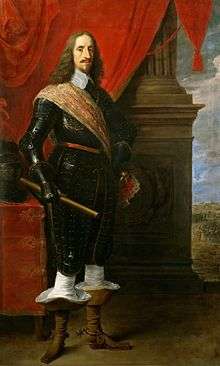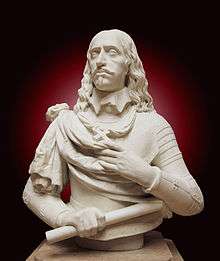Archduke Leopold Wilhelm of Austria

Archduke Leopold Wilhelm of Austria (January 5, 1614 – November 20, 1662) was an Austrian military commander, Governor of the Spanish Netherlands from 1647 to 1656, and a patron of the arts.
Biography
Born at Wiener Neustadt, he was the youngest son of Holy Roman Emperor Ferdinand II and Maria Anna of Bavaria (1574–1616), daughter of William V, Duke of Bavaria.
His elder brother became Emperor Ferdinand III (1608–1657). Leopold Wilhelm served as a general in the Thirty Years' War and the Franco-Spanish War (1635–1659). During the latter, the Spanish-Low Country forces under Leopold Wilhelm lost the Battle of Lens in an attempt to recover the city in 1648. Later in the war, he sallied forth from the Netherlands on two occasions. On the second, he successfully seized a number of northern French forts in February–March 1652, forcing the French to withdraw forces from Catalonia to reinforce their northern frontier. This assisted Spanish forces in Spain in recovering Catalonia from the French-backed Catalan rebellion.

Even though Leopold Wilhelm lacked the canonical qualifications, he was invested – with the help of his father – with a number of prince-bishoprics in order to provide him with an income. Unqualified as he was, he officially only held the title administrator—nevertheless realising the full episcopal revenues—of the prince-bishoprics of Halberstadt (1628–1648), Passau (1625–1662), Breslau (1656–1662), Olmütz (1637–1662) and Strasbourg (1626–1662). In 1635, Pope Urban VIII authorised him to become the prince-archbishop of Bremen, but due to its occupation by the Swedes he never gained de facto power.
He returned to Vienna after the situation in the Spanish Netherlands had deteriorated in 1656. In Vienna he was initially occupied with the administration of his various bishoprics, the Teutonic Order and the family affairs of the imperial house. After the death of his elder brother Emperor Ferdinand III several electors put him forward for the position of Emperor. However, he stalled to allow his nephew to reach the statutory age to ascend the imperial throne, which his nephew did as Leopold I on 22 July 1658 at the age of 18 years. After devoting himself to the affairs of state, Leopold Wilhelm retired in his final years and lived exclusively for the love of art.[1]
He died in Vienna in 1662.
Patron of the arts

When he assumed the government of the Spanish Netherlands, Leopold Wilhelm, being a great lover of art, employed several painters from the Antwerp Guild of Saint Luke, including the great Flemish painter David Teniers the Younger, who he not only employed as a painter but as keeper of the collection of pictures he was then forming. With the rank and title of "ayuda de camara," Teniers took up his abode in Brussels shortly after 1647.
.jpg)
Immense sums were spent in the acquisition of paintings for the archduke, including paintings by Frans Snyders, Pieter Snayers, Daniel Seghers, Peter Franchoys, Frans Wouters, Jan van den Hoecke, Pieter Thijs, Jan van de Venne and others. A number of valuable works of the Italian masters, now in the Vienna Museum, came from Leopold's gallery after having belonged to Charles I and the duke of Buckingham. He commissioned the British painter John Michael Wright to travel to Cromwell's England, and acquire art and artifacts.
When Leopold returned to Vienna, his collection of paintings was relocated to the Stallburg gallery in Hofburg Palace. Jan Anton van der Baren, a Flemish priest, who was also a first-rate flower painter, became director of the archducal gallery. Leopold bequeathed his gallery to his nephew Leopold I, and it became imperial property. It is now part of the Kunsthistorisches Museum in Vienna.
When the tomb of Childeric I, an early Merovingian king of the Salian Franks and father of Clovis I was discovered in 1653 (May 27) by a mason doing repairs in the church of Saint-Brice in Tournai, it was Leopold Wilhelm who had the find published in Latin.
Ancestors
Further reading
- Schreiber, Renate (2004). "Ein Galeria nach meinem Humor": Erzherzog Leopold Wilhelm. Vienna: Kunsthistorisches Museum. ISBN 3854970854.
- Liedtke , Walter A. (1984). Flemish paintings in the Metropolitan Museum of Art. New York: The Metropolitan Museum of Art. ISBN 0870993569. (see index, v.1, for more information on Leopold Wilhelm's patronage)
References
- ↑ Constantin von Wurzbach: Habsburg, Leopold Wilhelm. In: Biographisches Lexikon des Kaiserthums Oesterreich. Band 6. Verlag L. C. Zamarski, Wien 1860, p. 444–446 (German)
External links
![]() Media related to Archduke Leopold Wilhelm of Austria at Wikimedia Commons
Media related to Archduke Leopold Wilhelm of Austria at Wikimedia Commons
| Leopold William of Austria Born: 5 January 1614 in Wiener Neustadt Died: 20 November 1662 in Vienna | ||
| Catholic Church titles | ||
|---|---|---|
| Regnal titles | ||
| Preceded by Christian William of Brandenburg as Lutheran Administrator |
Prince-Archbishop of Magdeburg1 1631–38 |
Succeeded by Augustus, Duke of Saxe-Weissenfels as Lutheran Administrator |
| Prince-Bishop of Halberstadt1 1628–48 |
Secularised to the Principality of Halberstadt | |
| Preceded by Frederick II, Crown Prince of Denmark as Lutheran Administrator |
Prince-Archbishop of Bremen2 1635–45 |
Succeeded by Franz Wilhelm, Count of Wartenberg as Vicar Apostolic |
| Preceded by Leopold V, Archduke of Austria |
Prince-Bishop of Strasbourg1 1626–62 |
Succeeded by Franz Egon of Fürstenberg |
| Prince-Bishop of Passau1 1625–62 |
Succeeded by Archduke Charles Joseph of Austria | |
| Preceded by John Ernest Plateis of Plattenstein |
Prince-Bishop of Olmütz1 1637–62 | |
| Preceded by Karol Ferdynand Vasa |
Prince-Bishop of Breslau1 1656–62 | |
| Catholic Church titles | ||
| Preceded by John Caspar I, Lord of Stadion |
Grand Master of the Teutonic Order 1641–62 |
Succeeded by Archduke Charles Joseph of Austria |
| Government offices | ||
| Preceded by Manuel de Moura, Marquis of Castelo Rodrigo |
Governor of the Spanish Netherlands 1647–56 |
Succeeded by John of Austria, the Younger |
| Notes and references | ||
| 1. Catholic Administrator, due to lack of canonical qualification 2. De jure only; de facto he was barred by the Swedish occupants | ||